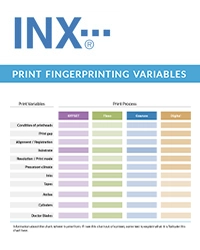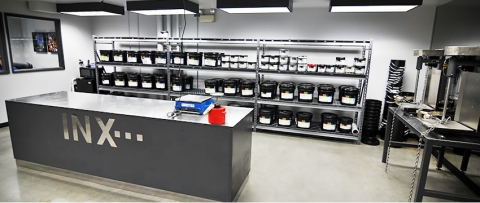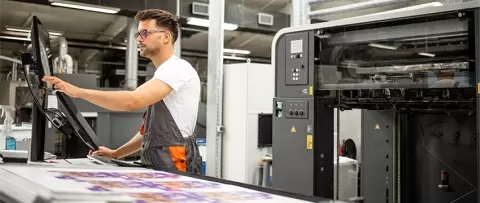Three Ways to Ensure Ink Doesn't Decrease Productivity
Color tolerance, quality control, and ink selection increase pressroom productivity
Ink quality, and the way it is used in the printing process, is a key component of successful printing. Strong results require a consistent approach and knowledge of variables. Regardless of print technology, printing is complex. Ongoing advancements in process automation have increased the reliability of operations and shortened the minutes spent getting a press up to color and getting profitable production underway. Staying reliably productive means controlling variables to eliminate unnecessary business risk. Ink, mechanical elements, chemistries, substrates, and software must harmonize to maximize productivity. This article addresses three ways ink quality can heighten productivity and includes a short list of other considerations that can bring great results.
1. Understanding Expected Color Tolerances
Printing productivity and profitability often hinge on managing color tolerances, and being unaware of them is like driving without a destination in mind. Tolerances may begin internally or may be determined by customer expectations. Do they require your company to maintain color accuracy within a set Delta E? If so, process variability is a concern. For instance, is the stock or substrate correct? Is the white point correct? Has the ink you’re using been manufactured to exacting standards, thus ensuring the highest probability of acceptable results while reducing the risk of rejected work?
To use ink as a specific example, the quality of the materials put into the manufacturing process directly affects the products that come out of it… sort of the opposite of “garbage in, garbage out.” Across processes, there are many choices among ink manufacturers. Business risk is minimized when a print producer works with a manufacturer with documented processes and carefully controlled production—they get what they need for success.
Working within tolerances means understanding their inherent limitations—printing is a realm of “best possible,” not of “perfection”. A Delta E of zero should be seen as an unreachable absolute. A Delta E of 1 is the color shift seen with the human eye. Quality printing stocks and even color measurement tools can possess a standard variability of .5 Delta E. Because of these realities, ink manufactured within exacting standards helps printers thread the needle of inherent production variabilities. The same goes for other controllable steps in your process.
2. Ensuring Ink Performance Through Quality Control (QC)
As an ink manufacturer, INX uses a strict quality-control program. This, in turn, improves color consistency and repeatability. In selecting an ink manufacturer to help make your production hours profitable, it is important to ask how they manage QC in the raw materials used and in their production process. Is there documentation of their QC processes? Can they give you the product you need to keep the presses running, versus chasing the moving target that an unreliable product can create? INX maintains valuable partnerships with printing companies worldwide because they have taken the time to design and implement stringent QC procedures and consistent production. Because of its automated systems and measurement tools, INX provides a more reliable product.
Having the best ink, the best press, or using top-grade stocks will get you only so far. Print providers must practice their QC efforts to maximize productivity and minimize business risk. In so doing, they can use the materials they purchase to create excellent, salable work. Documentation of QC efforts—the creation of data—is essential to determine, for instance, color shift. This type of data, faithfully and reliably collected, becomes the roadmap to bringing production back to where it needs to be. It can help you determine, for instance, where your color is in relation to the parameters within which it is judged. Anything else is guesswork. The lack of documentation can take the “why” out of production, creating unknowns.

Numerous posts in the INX Blog addressing color management, routine maintenance, color and production audits, the use of color standards all speak to the importance of holistic process control. While much must be managed and addressed to ensure consistency, the benefits of these efforts, including QC, are worth the effort. Again, documentation of these activities helps determine what has been done and where to focus when printing results go awry.
3. Prioritizing Ink Selection
The importance of ink selection has grown as specialized formulations have proliferated and available stocks include a broad range of porous and non-porous materials. Because of this, determining the ink set that will, for instance, transfer, release, and trap as expected has become more complex. This is where having a solid partnership with a quality-focused ink formulator brings a strong advantage. An expert formulator can ensure the ink used is correct for the substrate and the purpose of the printing, enabling printers to minimize waste and maximize production time. Regardless of the process or substrates they use, printers benefit by using the knowledge of their ink formulator.
Print Variables and Color Management
Today’s carefully formulated inks are engineered to come up to color quickly and then deliver consistency throughout the print run. However, making this concept a reality in print production, requires effective use of other chemistries and press setup that is appropriate for the job. While quality ink cannot control these other variables, its consistency can remove some of them from the challenges of strong production.
DOWNLOAD
Make sure you are considering all press optimization variables
Download Print Variables List
Color management and color profiling can bring order to the potential chaos of color, and strong attention to color by using color standards is truly a delineating factor between companies trying their best and those doing their best. But even the best color management programs require constant vigilance, employee training, documentation, and effective communication. For instance, an incorrect profile for an ink set or a stock can shift color, halting production.
One essential way to tighten a production process is to seek stability. In equipment, that means running consistently and not causing color shifts. In stock and substrates, it means using materials consistent in white point and finish, from sheet to sheet, meter to meter. Finally, it requires using inks that offer consistent color, viscosity, performance, and curing throughout the run and from job to job.
Conclusion: The Goal is Consistency
In printing where variables abound, consistency is the key to successful results. By understanding the tolerances mandated by customers and influenced by processes, printers can more reliably fulfill the job requirements. By taking advantage of the quality control procedures of quality formulators and implementing their own, internal quality assurance steps, they can more reliably gain and maintain color. By making appropriate ink selection a priority, they can ensure the ink put into the processes is suitable for the expectations of the final product. Finally, they can eliminate opportunities for project failure through careful attention to the broader process. The team at INX is committed to your success in using their inks productively and profitably.













